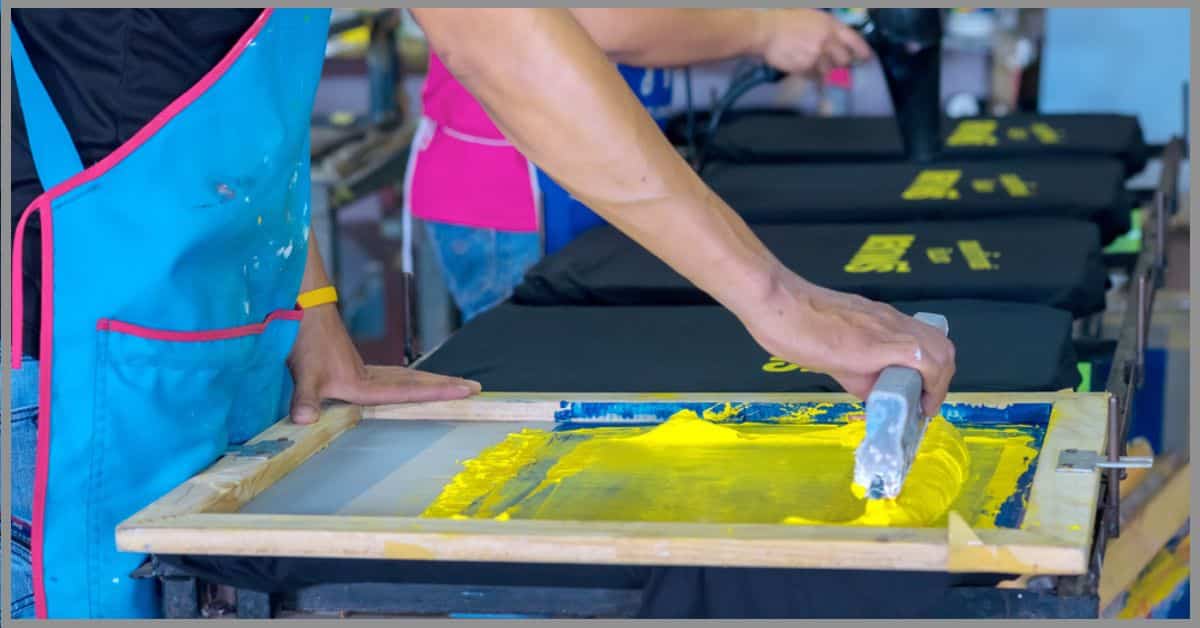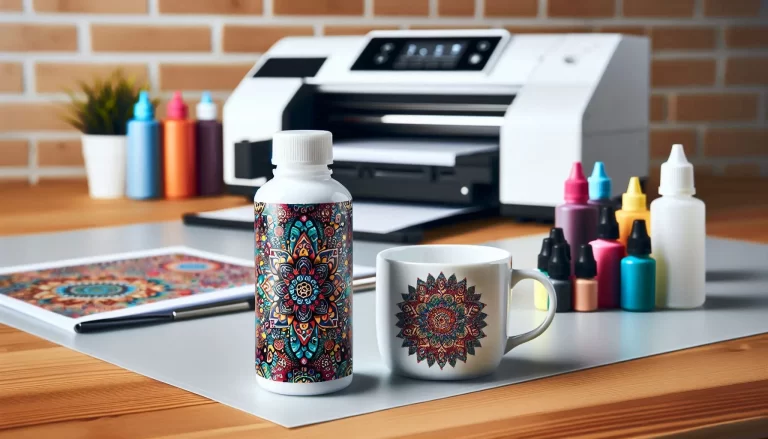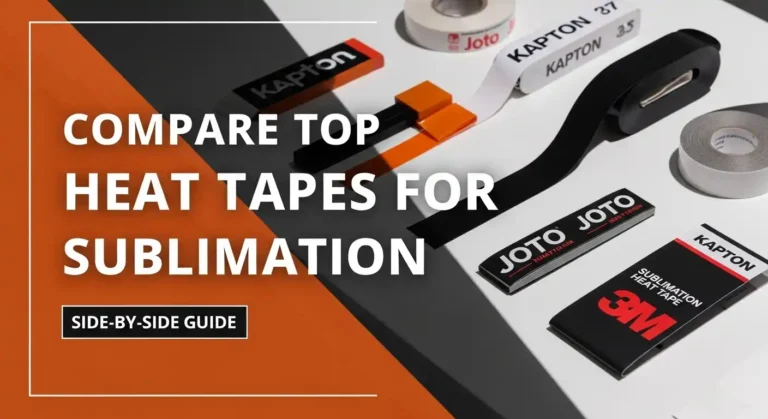Why I Prefer Sublimation Over Screen Printing
Trying to decide between sublimation and screen printing? Find out which method has a longer lifespan, is within your price range, and is most effective for your materials.
Get practical insights into durability, cost, and equipment that are clear and practical to help you make the decision-making process with sublimation vs screen printing.
Quick Comparison: Sublimation vs Screen Printing
Sublimation is perfect for printing vibrant, long-lasting designs on polyester and specially coated items, with low ongoing expenses, making it a great option for small runs.


Screen printing can be utilized on more materials, especially cotton, and is more cost-effective for large quantities, however, it may not hold up as well as sublimation over time.
If you’re uncertain whether sublimation or screen printing is the suitable option for your project, here’s a quick guide to help you decide.
| Feature | Sublimation | Screen Printing |
|---|---|---|
| Durability | Prints are vibrant and long-lasting, won’t crack or peel. | Durable, but may fade over time or with frequent washing. |
| Best for Materials | Ideal for polyester fabrics and specially coated items (mugs, phone cases). | Works well on cotton, polyester blends, and other materials. |
| Setup Cost | Initial investment for printer and heat press. | Higher initial setup cost for screens and press. |
| Cost per Unit (Bulk) | Low ongoing cost, especially for small runs. | Lower cost per item when printing large quantities. |
| Print Area | Full-color, all-over designs (ideal for apparel). | Best for simple, multi-color designs, usually on one area of the item. |
| Print Quality | Vibrant, photo-quality results. | Bold, solid colors with some limitations on detail. |

Definition and Process
Sublimation Printing
Sublimation printing is a method where heat is used to transfer dye onto materials like polyester fabrics or specially coated items. Here’s how it works:
- Design Creation: A design is created using graphic software.
- Printing: The design is printed onto a special sublimation paper using sublimation inks.
- Heat Transfer: The printed paper is placed on the material, and a heat press applies high temperature and pressure. The heat turns the dye into gas, which then permeates the material and solidifies, embedding the design into the fibers.
Sublimation printing is known for producing high-quality, vibrant prints that are durable and do not fade or peel.
Screen Printing
Screen printing, also known as silk screening, involves creating a stencil (or screen) and using it to apply layers of ink on the printing surface. The process involves:
- Design Preparation: A design is prepared and separated into individual colors.
- Screen Creation: Screens are made for each color in the design. These screens are coated with a light-sensitive emulsion and then exposed to light to harden the emulsion where the design should not be printed.
- Printing: The material is placed on a printing press, and ink is pushed through the screen onto the material using a squeegee. This is done one color at a time, layering the inks to build the final design.
- Curing: The printed material is then dried or cured, usually using heat, to set the ink.
Key Differences
Understanding the key differences between sublimation and screen printing will help you make an informed decision based on your specific needs and preferences.
Printing Process
- Sublimation Printing: Involves turning dye into gas through heat, which then permeates the material and solidifies. This results in a print that becomes part of the fabric, making it very durable and long-lasting.
- Screen Printing: Uses a stencil to apply layers of ink onto the material. Each color requires a separate screen, making the process more complex for multi-colored designs but highly effective for large quantities.
Material Compatibility
- Sublimation Printing: Best suited for polyester and polyester-coated substrates. It does not work well on cotton or dark fabrics.
- Screen Printing: Versatile and can be used on almost any material, including cotton, polyester, blends, and even non-fabric items like wood and metal.
Color and Design Capabilities
- Sublimation Printing: Excels at producing high-quality, full-color images with fine details. Ideal for complex designs with gradients and multiple colors.
- Screen Printing: Great for bold and vibrant colors, but each color in the design requires a separate screen, making it less efficient for highly detailed or multi-colored designs.
Durability
- Sublimation Printing: The design becomes part of the fabric, resulting in prints that won’t crack, fade, or peel over time, even with repeated washing.
- Screen Printing: This creates a layer of ink on top of the fabric, which can be very durable but may eventually crack or fade with extensive use and washing.
Cost and Efficiency
- Sublimation Printing: Generally more expensive upfront due to the cost of sublimation inks and the need for special printers and heat presses. More cost-effective for small to medium batches and custom or detailed designs.
- Screen Printing: Cost-effective for large orders due to the ability to reuse screens for bulk printing. However, the initial setup cost can be high due to the preparation of multiple screens for multi-colored designs.
🖼️ Sublimation vs. Screen Printing

✨ Advantages of Each Method
🔥 Sublimation Printing
- Vibrant Prints: High-quality, detailed images with full color range
- Durability: Won’t crack, fade, or peel with washing
- Soft Feel: Maintains fabric’s original texture
- No Color Limits: Handles complex designs without extra cost
🖍️ Screen Printing
- Cost-Effective: Best for bulk orders
- Versatile: Works on many materials
- Bold Colors: Great for dark fabrics
- Special Effects: Metallic, glitter, and puff ink options
⚠️ Limitations to Consider
🔥 Sublimation Challenges
- Material Limits: Only works on polyester/coated items
- Startup Costs: Equipment can be expensive
- Color Restrictions: Not ideal for dark fabrics
🖍️ Screen Printing Challenges
- Multi-Color Complexity: Each color needs separate setup
- Heavy Feel: Ink layers may be noticeable
- Durability: Can crack/fade over time
- Environmental Impact: Uses more chemicals/water

Example of vibrant sublimation printing
Ready to Choose Your Method?
Explore Printing Solutions →💰 Cost Comparison
Cost is a crucial factor when deciding between sublimation and screen printing, as it can significantly impact your budget and overall project feasibility.
🏗️ Initial Setup Costs
🔥 Sublimation Printing
Higher initial investment for printer, heat press, inks, and transfer paper. More cost-effective for small to medium runs after setup.
🖍️ Screen Printing
Substantial setup costs for screens (per color) and equipment. Labor-intensive setup but becomes economical for large quantities.
📊 Cost Per Unit
🔥 Sublimation
Consistent cost per unit regardless of quantity. Ideal for custom/personalized items and small batches.
🖍️ Screen Printing
Cost per unit drops significantly with volume. Higher per-unit cost for small runs due to screen setup requirements.
⏳ Long-Term Cost Efficiency
🔥 Sublimation
Excellent for on-demand production with minimal setup/cleanup. Saves time and resources for businesses handling custom orders.
🖍️ Screen Printing
Best for mass production where high volumes justify initial setup costs. Lower per-unit costs at scale.
📈 Cost Comparison At Different Quantities
| Quantity | Sublimation | Screen Printing |
|---|---|---|
| 1-10 items | $$$ (Best option) | $$$$ |
| 10-50 items | $$ | $$$ |
| 50+ items | $$ | $ (Best option) |
Need Help Deciding?
Get Personalized Advice →Best Use Cases
Choosing the right printing method often depends on the specific application and requirements of your project. Here are the ideal use cases for sublimation and screen printing:
Ideal Scenarios for Sublimation Printing
- Custom Apparel: Perfect for creating custom t-shirts, sportswear, and fashion items with vibrant, full-color designs. It’s especially effective on polyester fabrics.
- Promotional Items: Suitable for printing on polyester-coated items like mugs, mousepads, and phone cases. The prints are durable and vibrant, making them ideal for promotional giveaways.
- Photographic Prints: Great for designs that include photos or intricate, multi-colored graphics. The high-resolution output makes it ideal for personalized gifts or high-end products.
- On-Demand Printing: Excellent for small runs and personalized items. Since there’s no need for screens or extensive setup, it’s efficient for producing unique, one-off pieces quickly.
Ideal Scenarios for Screen Printing
- Bulk Orders: Highly cost-effective for large quantities of t-shirts, hoodies, bags, and other apparel. The setup costs are spread across many items, reducing the overall cost per unit.
- Simple Designs: Ideal for bold, simple designs with few colors. The thick, vibrant ink creates strong, opaque prints that stand out, especially on dark fabrics.
- Special Effects: Allows for the use of special inks and effects like metallic, glitter, puff, and glow-in-the-dark. This is great for unique, eye-catching designs.
- Variety of Materials: Suitable for a wide range of materials beyond fabric, including paper, wood, metal, and glass. This versatility makes it a popular choice for various industries.
Durability and Longevity
The durability and longevity of the printed design are essential factors to consider, especially for items that will undergo frequent use and washing.
Durability of Sublimation Printing
- Integration with Fabric: Sublimation prints become part of the fabric itself, resulting in designs that do not peel, crack, or fade over time. The dye penetrates the fibers, ensuring long-lasting vibrancy and durability.
- Resistance to Wear and Tear: Sublimation is highly resistant to washing, friction, and exposure to sunlight, making it ideal for sportswear, outdoor gear, and frequently worn items.
- Color Fastness: Since the dye is embedded in the fabric, colors remain bright and vivid even after multiple washes and prolonged use.
Durability of Screen Printing
- Thick Ink Layers: Screen printing applies a thicker layer of ink on the surface, providing excellent opacity and brightness, particularly on dark fabrics. The print can withstand many washes, though it may eventually show signs of wear.
- Potential for Cracking: Over time and with frequent washing, screen-printed designs may start to crack or peel, especially if not properly cared for. The durability can be enhanced by using high-quality inks and proper curing techniques.
- Maintenance: To ensure longevity, screen-printed items should be washed inside out in cold water and dried on low heat. This helps maintain the integrity of the print for a longer period.
Environmental Impact
It’s crucial to consider the environmental impact of your printing method in today’s world. Here’s how sublimation and screen printing compare when it comes to sustainability.
Environmental Impact of Sublimation Printing
- Low Waste Production: Sublimation printing produces minimal waste. The process uses exact amounts of dye, and any excess sublimation paper can often be recycled.
- Water Usage: This method requires no water during the printing process, reducing water consumption significantly compared to traditional methods.
- Eco-Friendly Inks: Many sublimation inks are water-based and non-toxic, reducing the release of harmful chemicals into the environment. However, the production of polyester, the primary material for sublimation, has its environmental concerns.
Environmental Impact of Screen Printing
- Chemical Usage: Screen printing involves the use of various chemicals, including emulsions, inks, and cleaning solvents. These can be harmful to the environment if not disposed of properly.
- Water Consumption: The process can be water-intensive, especially during screen cleaning and reclaiming. This increases water usage and the need for effective wastewater management.
- Ink Options: While traditional plastisol inks contain PVC and phthalates, more eco-friendly options like water-based and discharge inks are available. These alternatives reduce the environmental footprint but still require careful handling and disposal.
Sustainable Practices
- Sublimation Printing: To enhance sustainability, choose sublimation inks that are certified eco-friendly and use recycled polyester fabrics.
- Screen Printing: Implementing sustainable practices like using water-based inks, reclaiming screens efficiently, and properly managing waste can reduce the environmental impact.
Choosing between sublimation and screen printing for custom apparel depends on your specific needs. Sublimation printing offers durability, vibrant colors, and customization options, making it ideal for synthetic fabrics and intricate designs.
On the other hand, screen printing provides cost-effective solutions for bulk orders, vibrant opaque colors, and versatility across different fabric types.
By evaluating the advantages of each method and taking into account factors such as quantity, design complexity, and fabric compatibility, you can make an informed decision and create exceptional custom apparel that meets your needs.
For a comparison with other eco-friendly options, check out our guides on Soy-Based Inks and UV-Curable Inks.





3 Comments